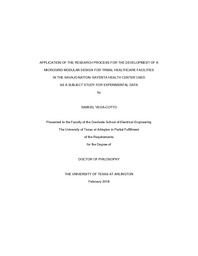
ATTENTION: The works hosted here are being migrated to a new repository that will consolidate resources, improve discoverability, and better show UTA's research impact on the global community. We will update authors as the migration progresses. Please see MavMatrix for more information.
Show simple item record
| dc.contributor.advisor | Lee, Wei-Jen | |
| dc.creator | Vega-Cotto, Samuel | |
| dc.date.accessioned | 2018-06-05T16:15:11Z | |
| dc.date.available | 2018-06-05T16:15:11Z | |
| dc.date.created | 2018-05 | |
| dc.date.issued | 2018-05-09 | |
| dc.date.submitted | May 2018 | |
| dc.identifier.uri | http://hdl.handle.net/10106/27366 | |
| dc.description.abstract | There exist significant challenges and opportunities for improvement the power system of healthcare facilities for American Indian and Alaska natives. This Dissertation establishes plans and methodology to include the research process in the power system
design utilizing Kayenta health center, which is located in the Navajo nation, as a subject study. Information about the solar irradiance on site, the PV system performance, the power quality and the power system load demand at the facility as well as observation of the related equipment is gathered.
The Dissertation describes a seasonal experimental process related to a 100KW PV system case study at the Kayenta Health Center and is supplemented with detailed information about the power system of the facility. Detailed study of existing PV system at the Kayenta Health Center combined with modeling and simulation tools is used to discover additional information, process and methodology for the implementation of the microgrid in other tribal health care facilities at the Navajo Nation. Seasonal experimental data validated with theoretical data available for the zone, the facility, the systems and
the equipment is used to develop a concept model for the actual implementation.
Targeted information about harmonics provides insight about specific features of the concept model. The concept model is adjusted such that the actual implementation of the microgrid will enhance the power quality, result in optimum power system design, produce energy savings and reduce environmental pollution.
The concept model of microgrid architecture lead to the development of a proposal for the implementation of the microgrid at Dilkon Health Center, which is a facility in the IHS New Construction Priority List. The Microgrid proposal was accepted
and adopted by the management of Division of Engineering Services from Indian Health Services. The proposal basically use previous research information and the concept model and apply a procedure and cost estimates for a specific facility (Dilkon HC). The proposal include different type of language (cost vs benefits instead of highly technical)
because it have the intent of convince the different stakeholders. The proposal is a necessary stage between the research and the actual implementation.
The research foundation presented can be applied for additional proposals of Microgrid implementation or power system improvements in other healthcare facilities and staff quarter projects. | |
| dc.format.mimetype | application/pdf | |
| dc.language.iso | en_US | |
| dc.subject | Microgrids | |
| dc.subject | Tribal healthcare facilities | |
| dc.subject | Renewable energy | |
| dc.subject | PV systems | |
| dc.subject | Indian Health Service | |
| dc.subject | Experimental | |
| dc.subject | Winter | |
| dc.subject | Summer | |
| dc.subject | Concept model | |
| dc.subject | Kayenta | |
| dc.subject | Dilkon | |
| dc.subject | Power systems | |
| dc.title | APPLICATION OF THE RESEARCH PROCESS FOR THE DEVELOPMENT OF A MICROGRID MODULAR DESIGN FOR TRIBAL HEALTHCARE FACILITIES IN THE NAVAJO NATION: KAYENTA HEALTH CENTER USED AS A SUBJECT STUDY FOR EXPERIMENTAL DATA | |
| dc.type | Thesis | |
| dc.degree.department | Electrical Engineering | |
| dc.degree.name | Doctor of Philosophy in Electrical Engineering | |
| dc.date.updated | 2018-06-05T16:16:14Z | |
| thesis.degree.department | Electrical Engineering | |
| thesis.degree.grantor | The University of Texas at Arlington | |
| thesis.degree.level | Doctoral | |
| thesis.degree.name | Doctor of Philosophy in Electrical Engineering | |
| dc.type.material | text | |
| dc.creator.orcid | 0000-0002-6377-4885 | |
Files in this item
- Name:
- VEGACOTTO-DISSERTATION-2018.pdf
- Size:
- 7.366Mb
- Format:
- PDF
This item appears in the following Collection(s)
Show simple item record


